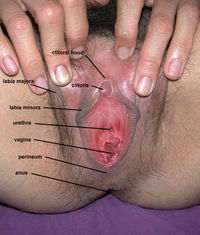Clitoral hood

If you are looking for piercings of the clitoral hood, visit the entries on vertical hood piercing and horizontal hood piercing. Other modifications of the clitoral hood include hood removal, hood splitting, and other forms of female circumcision.
The clitoral hood (or prepuce) is the hood of skin that covers the clitoris. Loosely speaking, it is the female equivalent of the male foreskin. It varies massively from woman to woman: some are symmetrical, some are lop-sided, others are large, and others are almost non-existent. Some clitoral hoods block sensation from reaching the clitoris, and others effectively stimulate the sensitive clitoris. In some people the hood may merge with the inner labia. Because the clitoris is able to become erect (like a penis does, just smaller), the hood may cover the clitoris at some times but not others.
The anatomy of the clitoral hood will determine what types of procedures are possible. If the hood is too small or too tight, there will be restrictions on what will be safe and comfortable.